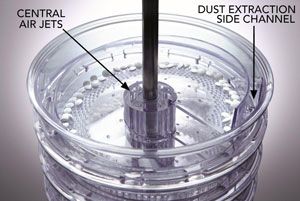Addressing Dust Accumulation in Tablet Manufacturing
Dedusting equipment and techniques address problems associated with tablet manufacturing dust accumulation.
The problems associated with the accumulation of dust in the tablet manufacturing process are numerous and varied. Particle buildup in production and/or packaging equipment, for example, can result in jams, obscured sensors, or faulty packaging closure, especially in the case of blisters or strips. Dust is one of those seemingly minor issues that, if not properly managed, can exponentially affect an entire operation, particularly by necessitating unacceptable duration and frequency of downstream (post tablet compression) cleaning. Other potential problems include increased operator exposure to APIs on packaging lines and, if the issue isn’t corrected in-house, diminished patient confidence in the end product due to rough burrs around tablet edges or logos, or unsightly dust at the bottom of a bottle that could even threaten prescription compliance.
A number of technological innovations have greatly improved the dedusting process in recent years, and dedusting equipment manufacturers have begun incorporating them into their latest products. Following are a few considerations.
Dedusting performance
As manufacturing processes get faster, more sophisticated, and altogether more demanding, traditional vibration-and-vacuum deduster designs are no longer sufficient for optimal dedusting performance. Solutions incorporating compressed air-jet assist and a circumferential dust-extraction curtain can more efficiently perform the required level of dedusting on modern pharmaceutical production lines.
Figure 1. Dust extraction is provided by a circular channel on the spiral's outside circumference. Image courtesy of Pharma Technology Inc.

These innovations allow dust extraction to be provided by a continuous circular channel on the spiral’s outside circumference, with a compressed air in-feed from the center channel (see Figure 1). Essentially, this creates a curtain of dust extraction air right around the outer circumference of the spiral, as close as possible to the path of the tablets. The compressed air jet blows radially from the center column at each turn of the spiral and produces air flow that helps tumble the tablets and push any loosened dust towards the dust extraction curtain at the circumference of the spiral.
According to tests conducted in 2011 by a major German contract manufacturer in conjunction with a local university, these innovations have improved process performance by more than 40% when measuring weight variation of tablets before and after dedusting, as compared with older models that use a traditional stainless-steel spiral design with a central tube aspiration and no compressed air jet.
Height gain advantages
The development of taller, elevating spiral dedusters has enabled significant performance improvements. Dedusting performance continuously improves as height is gained up to 30 inches. The height gain is measured by calculating the difference between the deduster’s tablet entry point and the exit point of either the deduster or attached metal detector. Above 30” in height, the additional upward conveying essentially allows the integration of additional functions. Some of the tallest elevating spiral deduster models can raise tablets as high as seven feet within the same footprint as a shorter deduster, allowing for combined units that include metal detection, a buffer hopper for discharge into an intermediate bulk container, and/or a multi-way diverter for discharge into drums on a pallet with a balance underneath.
A taller system also allows primary or secondary sampling of tablets either before the dedusting process or after the metal detector. These samples can be sent to an automated three-parameter tablet tester for weight, thickness, and hardness in-process control checks.
Quick changeover
Segmented spirals made of either polymer or stainless steel allow easier and faster dismantling, cleaning, drying, and reassembly as compared with traditional one-piece stainless-steel spirals. The newer segmented spirals come with no dirt traps, and stainless-steel models come with fully continuous TIG (Tungsten Inert Gas) welds for a smooth surface and avoidance of gaps and crevices where dust can get trapped.
Dust-tight design
Fully enclosing the tablets is important not only inside the deduster, but when transferring the tablets from the press into the metal detector and discharging them into their final container. A complete dust-tight system avoids dust contamination of the room and other equipment and facilitates clean-down time of the equipment and the compression room. Silicone connections and a design with no windows or glued or pressed seals enable dust tightness.
Containment
Modern, high-containment units for handling highly potent materials use the same design as the dust-tight units and include the addition of containment valves on the tablet inlet, tablet outlet, dust extraction/drain connection, and air inlet. A high-efficiency particulate air (HEPA) filter also can be added on the air inlet for additional safety. These features typically allow for operation at a protection level at or lower than occupational exposure band (OEB) 5.
Finally, wash-in-place or wash offline units allow for the automated washing and rinsing of the high-containment units after a batch is completed. This system helps maintain the OEB 5 or lower exposure level when the deduster/metal detector is disconnected, dismantled, and washed.
About the Author
Nic Michel is General Manager, North America for Pharma Technology Inc. (www.pharmatec-inc.com), which develops and supplies tablet dedusters and capsule polishers combined with metal detectors and loading systems for pharmaceutical solid dose production.